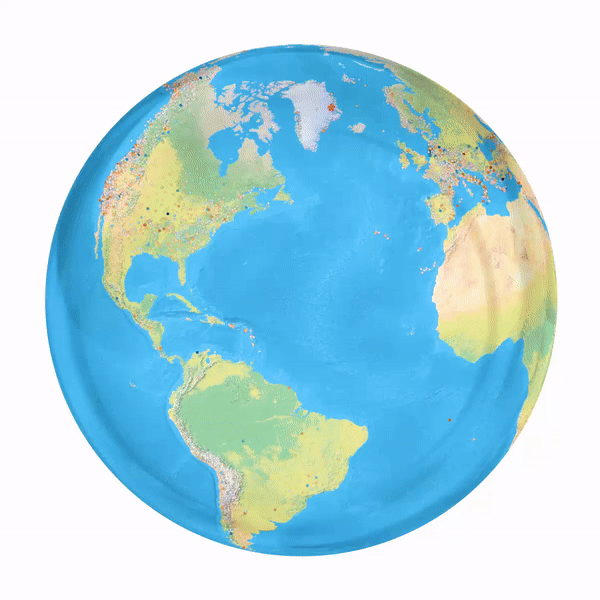Last year, a massive but brief burst of seismic energy was followed by a long aftershock that caused quite a stir around the world and required the help of 68 scientists and the Danish military to find its cause.
According to RCO News Agency, On September 16, 2023, the world began to roar. A massive rock avalanche crashed into the deep waters of a fjord in East Greenland, unleashing a megatsunami whose initial waves reached a height of 200 meters. The waves washed the walls of the fjord before flowing into the open sea.
Even for this avalanche-prone spot in Greenland, the collapse and subsequent megatsunami were shocking because of its speed and intensity, according to Quanta. But what happened next was much stranger. This event triggered a monotonous aftershock that lasted nine consecutive days and was strong enough to be detected by seismometers around the world. However, when members of the Danish military visited the scene, they found nothing.
Kristian Svennevig, a geologist at the Geological Survey of Denmark and Greenland and a member of the team that investigated the anomaly, said: “It’s a crazy thing and it’s like nothing else that’s been seen before.” .
“Immediately, a lot of researchers joined forces,” said Finn Løvholt, a tsunami and landslide researcher at the Norwegian Geotechnical Institute in Oslo. This group grew rapidly and consisted of experts from 15 different countries. The Danish Navy also provided assistance. But no one could suggest anything as an underlying reason, and everything from strange magma movements to shifting ice sheets seemed to make sense.
Stephen Hicks, a member of the team and a seismologist at London College, joked: “If we had no other explanation, we’d be looking for a sea monster or a baby dragon.”
Now, as reported in the journal Science, a group of 68 scientists has managed to identify the origin of the world’s seismic hums, a strange natural phenomenon that beats rhythmically like a drum on Earth’s surface.
“I don’t know if anyone has seen anything even remotely like this before,” said Ben Fernando, a seismologist at Johns Hopkins University who was not involved in the new study.
The joy of discovering strange things has humbled and delighted the group. This is probably why many of these people entered science, says Essonvig. With all the fancy equipment and knowledge we have, every once in a while we still find something we don’t know.
Explosion and earthquake
On September 16 last year, at 11:35 a.m. East Greenland time, a sheet of ice became too thin after years of warming due to climate change. On the side of a mountain peak above Dickson Fjord, about 25 million cubic meters of rock, about 10 times the size of the Great Pyramid of Giza, moved down and roared like lightning into a glacier in a gully. He hit and destroyed it.
This stone avalanche fell into the fjord at a speed of more than 160 km/h and created a megatsunami with an average wave height of 110 meters.
Megatsunamis are usually formed when a large, high-speed mass sinks into a compressed body of water. The combination of very high waves and high speed has a very destructive potential.
The initial landslide and subsequent rock-ice avalanche made a lot of noise. Its sonic roar was picked up more than 3,300 kilometers away in Russia by an infrasonic instrument designed to detect secret nuclear weapons tests. The seismometers also picked up a series of high-frequency seismic events along with some low-frequency waves.
What happened after that was not so simple.
Seismologists detected a deep tremor at 10.88 MHz. “It looked like a really big anomaly,” Hicks says. They watched it go on for a day, and then other researchers around the world were amazed. what’s going on here Why are we still seeing this?
By the time the quake died down after nine odd days, a variety of experts, from tsunami researchers to deep-earth geologists, had gathered in a sprawling group on an open-source platform called Mattermost.
They discussed a variety of possible explanations.
The seismic signals did not match the signature of an earthquake. They hypothesized that perhaps an ice sheet metamorphosed by a rockfall would ring like a bell. Perhaps a landslide caused a piece of ice to melt and that water moved through a natural plumbing system in a glacier, turning it into an instrument and creating the geological equivalent of music. Or maybe Greenland’s hum is the work of some unknown volcanoes.
No evidence was available to support any of these ideas. People jokingly started to come up with ideas that maybe aliens were involved or angry dragons causing a ruckus. “When anomalies like this baffle seismologists, the name of some sort of mythical colossal monster always comes up,” Hicks says.
Three days after the great slide, the Danish Navy surveyed the fjord to describe the altered landscape. To them, everything seemed peaceful.
Despite the lack of conclusive evidence, a hypothesis remained. Perhaps the avalanche created a standing wave that moves back and forth in the fjord. Such a wave, called a seiche, is common in lakes and harbors, although it usually forms in the presence of strong winds.
Then, just three weeks after the dramatic events of September, a second (weaker) seismic signal emanated from the fjord and spread across the planet. This seismic signal also appeared to be caused by a landslide and was accompanied by a smaller tsunami. Examining historical seismic records dating back to the early 1980s, the team soon found four similar events. If those signals were caused by sishes, then perhaps the September quakes were also caused by them.
But there was an obvious problem with Sish’s hypothesis. Avalanche and tsunami were big and powerful, but fleeting. It was not clear how a 9-day sesh was created and maintained.
Desperate, one member of the group attempted to recreate the long-overdue sloppiness in his bathtub. Unfortunately, Dixon is not a straight and symmetrical fjord, so a bathtub is not a good option and the experiment didn’t work.
The team then tried to model the event on a computer. In their first attempt to make a numerical simulation of the tsunami, they were unable to reconstruct the sish. The Danish military then gave them access to high-resolution sonar surveys of the bottom of the baroque fjords. That’s when the evidence started to pile up.

Simulations that took into account the variable depth of the fjord showed that the megatsunami was stabilized in a sish with a dominant frequency of 11.45 MHz, which is very close to the 10.88 MHz frequency of the 9-day freak quake. The unfavorable geography of the fjord suggests that the sish’s energy gradually leaks into open waters, which helps explain its longevity.
Their simulations also revealed why the Danish Navy failed to see the Sish waves. Sish moved 2.7 km from one side of the fjord to the other every 45 seconds. After only three days, the height of the wave was reduced to a few centimeters, making it imperceptible to the people present.
This study confirms that our rapidly warming world can affect us in surprising ways. The landslide that started that megatsunami was caused by a melting layer of ice. Climate change is present in the background of this story. Now researchers will be on the lookout for similar warning signs in other parts of the planet’s glaciers that are vulnerable to megatsunamis.
Nine days of global shaking may be impressive, but it is not a record. The devastating 9.1 magnitude Sumatra-Andaman earthquake and tsunami in December 2004 rocked our planet for 18 days, and it is thought that the Chicxulub asteroid, which ended the reign of dinosaurs on Earth 66 million years ago, after impact , has created a commotion on the ground for months.
The difference with the Greenland earthquake is that this case fortunately caused less damage and had zero casualties. “This kind of science is the most fun,” says Hicks.
end of message
RCO NEWS
















